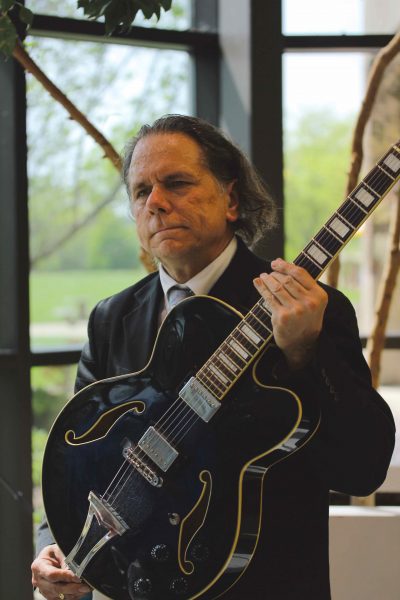
Steve Somers performing during an on-campus event. Vardan Sargsyan | Washtenaw Voice
By Danny Villalobos
Staff Writer
Professor Steve Somers teaches music at WCC. He has been a part of WCC for 17 years and currently teaches the Jazz Combo and Improvisation class and will be teaching two guitar classes for next winter semester. Other than teaching at WCC, Steve also leads his own band.
Q: Can you give a summary of your background?
A: I’ve been teaching the jazz combo class here, which is my main class, for probably close to 3 to 4 years now. I studied at Eastern [Michigan University], I have a masters in music from [there] which I completed in 1986. I do a lot of community events also, different performances I sometimes do with students and alumni.
Q: How long have you been a musician?
A: I [began] playing music right around 1965, so I’ve been at it for about a good 50 years. I grew up in California in the bay area around Berkeley and Oakland, so I was exposed to a lot of music there. I have my own band which does a lot of variety of jazz, blues, and popular music.
Q: When did you start to take an interest in jazz?
A: Initially I was taken by the pop music [in those] days like the Beatles, and the Rolling Stones. Groups like Santana were coming up from the bay area and so he was an influence; and I was influenced by a lot of the blues, like BB King and Albert King. I had some private teachers as a teenager, they were teaching in more of a jazz style. So, I ended up being very serious about it. Jazz takes more technique and a little more work than a lot of the basic pop styles, you know?
Q: What’s your favorite type of jazz?
A: I sort of prefer the modern jazz that has interesting chord progressions and different harmonies. I like a lot of the Latin jazz, as well as some of the swing, and I appreciate a lot of the original composition too.
Q: How did you learn to hone your talents?
A: I was studying a lot of jazz on my own, practicing a lot, gaining more experience, [and] performing at different venues. Back in the 60’s I ended up leaving school probably 10th or 11th grade. I really wasn’t interested in getting a formal education even though my dad was a professor. I wanted to focus on the music.
Q: Is the guitar the only instrument you play?
A: Guitar is the main instrument. When you go to a school program, like EMU, you do a little bit of keyboard and piano, especially for composing and writing music, so I play a little bit of piano. When I was in college, I played some saxophone, but the guitar is pretty much my main instrument, so I stuck with that.
Q: Where do you see the future of the guitar in jazz?
A: Sometimes, guitar tends to be minimized when there’s a piano or keyboard in the group. Guitar and piano both do similar things, both are played in chords, as well as melodies. Some, musicians prefer a piano over a guitar, or sometimes guitar gets pushed to the background, personally, I really don’t care for it, I’d personally rather hear guitar than the piano.
Q: What’s your philosophy on teaching jazz?
A: A lot of emphasis on improvisation and understanding improvisational concepts and getting some experience doing it. Because often times at a school, a high school, or even a college jazz band, often a lot of the music is just written out and you don’t get the chance to improvise. So we do stress the element of improvisation, so we do develop concepts for constructing a solo.
Q: How do you teach students who never played an instrument or who don’t have an idea of what jazz is?
A: We try to encourage them to listen to jazz. With the internet, there’s a lot of resources in listening to this type of music, to get them familiar with the music, with different styles. If someone is inexperienced with an instrument or not proficient, sometimes we’ll have them play percussion– but the class is designed for everyone to join in.
Q: What are some jazz essentials for students and for regular folk?
A: Some of the early Miles Davis, a song called, “So What?”, or “Night in Tunisia” which combines elements of Latin rhythms with jazz. It’s important to understand the bossa nova and samba is essentially using jazz-type chord progression, but with Latin beats, and it’s important to differentiate between a latin style and a swing jazz style. Latin is more of the straight ahead, whereas the swing jazz has a little bit of a bounce to it, usually a walking bass line.
This interview has been edited and condensed.

